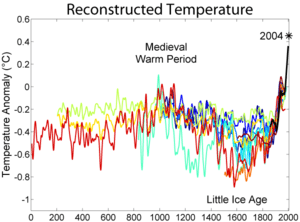1912 United States cold wave
The 1911-1912 United States cold wave (also called 1912 cold air outbreak) remains one of the coldest winters recorded to occur over the northern United States since meteorological data has been kept by the United States Weather Bureau, which was established in 1870. The cold wave started in November 1911 and continued into March 1912.
Early winter

The cold weather started early in winter, with November being the coldest on record over the contiguous US at 37.27 °F or 2.93 °C.[1] December was relatively mild east of the Continental Divide, but in January 1912 Michigan with an average of 4.0 °F or −15.6 °C, Wisconsin at −5.1 °F or −20.6 °C and Minnesota with an average of −9.4 °F or −23.0 °C set records for their coldest month on record. Minneapolis set a record with 186 consecutive hours of sub-zero temperatures, from 8 pm on December 31 until 1 pm on January 8; after four hours slightly above zero the temperature dropped below for another 121 hours, until 10 am on January 13.[2]
The cold air moving south from the Arctic caused many places in the northern United States to be severely cold, with extreme wind chills. In early January cold air kept moving south from an Arctic pressure system, bringing some of the coldest air seen in the United States since 1886. The cold wave is reported to have killed 47 Americans in the first two weeks.[3]
In January 1912, Sioux Falls saw a record low temperature for the twentieth century of −38 °F (−39 °C). That area also saw the longest stretch of below-zero weather for a single winter. Niagara Falls froze so densely that some people were able to safely cross on ice bridges.
Later winter
February and March continued the unrelenting freeze. Both months were unusually cold, and March was the second-coldest on record for the contiguous US, and very wet with widespread heavy snowfalls. Parts of North Dakota saw their lowest recorded March readings to date.

Some cities saw their coldest weather that winter since the Little ice age.
1912 itself was a very cool year: The contiguous United States saw its coolest calendar year on record by maximum temperature[4] and second coolest by mean temperature, just behind 1917,[5] when fifteen eastern states saw their coolest year on record. The 1910s and 1920s were known for cold weather in almost all seasons.
Aftermath
The U.S. Department of Agriculture reported that the late-December freeze cost the California citrus industry $6,000,000 ($147,400,000 today), but that the Department’s frost warning, which they considered one of the greatest weather forecasting successes of the year, saved the industry from an additional $14,000,000 ($343,900,000 today) in damages.[6] These cold waves led to the first use of “frost heaters” to protect against the threat either via electric heaters or special sheds.[7] These were to reduce the risk of damage in further extreme cold waves such as those of January 1937 in California and January 1940 in Florida.
See also
References
- ↑ Climate at a Glance; National Oceanic and Atmospheric Administration
- ↑ Mogil, H. Michael (2008-12-19), Cold Waves in Minneapolis, Minnesota, Yahoo!, retrieved 2013-01-26
- ↑ "COLD WAVE IN AMERICA.". The Mercury (Hobart, Tas. : 1860 - 1954). Hobart, Tasmania: National Library of Australia. 1912-01-10. p. 5. Retrieved 2013-01-26.
- ↑ Contiguous United States Maximum Temperature, January to December; National Oceanic and Atmospheric Administration
- ↑ Contiguous United States Maximum Temperature, January to December; National Oceanic and Atmospheric Administration
- ↑ United States Department of Agriculture (1913), Yearbook of the United States Department of Agriculture, 1912, p. 37, retrieved 2013-01-26
- ↑ ‘Culture of Citrus Groves in Gulf States’; Farmers’ Bulletin; 526 (April 1913); p. 12
External links
- Monthly Weather Review, 1912, NOAA.